Dont forget that chines have very good numbers of SU 30Mkk (which is superior due sone addon to indian SU 30Mki ) and 24 SU 35 . These are modified with Chinese weapons along with Russians, addition to there deomestic aircraft lineup.Why French Rafale Fighters and Meteor Missiles Can’t Solve India’s Problem with China’s Air Force
Following multiple border clashes with Pakistan in 2019 and more recently with Chinese forces in Galwan Valley, a number of Indian officials and military analysts have referred to the French Rafale fighter as a guarantor of a favourable outcome in future conflicts. The Rafale is a ‘4+ generation’ French fighter which first flew in 1986, and the Indian Air Force plans to induct 36 of the aircraft into service by 2025. The fighter is particularly prized for its low operational cost and maintenance requirements, although its compatibility with Meteor and SCALP missiles and respectable avionics have also been attractive. Despite these strengths however, the Rafale’s ability to seriously benefit Indian operations against China in particular remain extremely limited for a number of reasons.
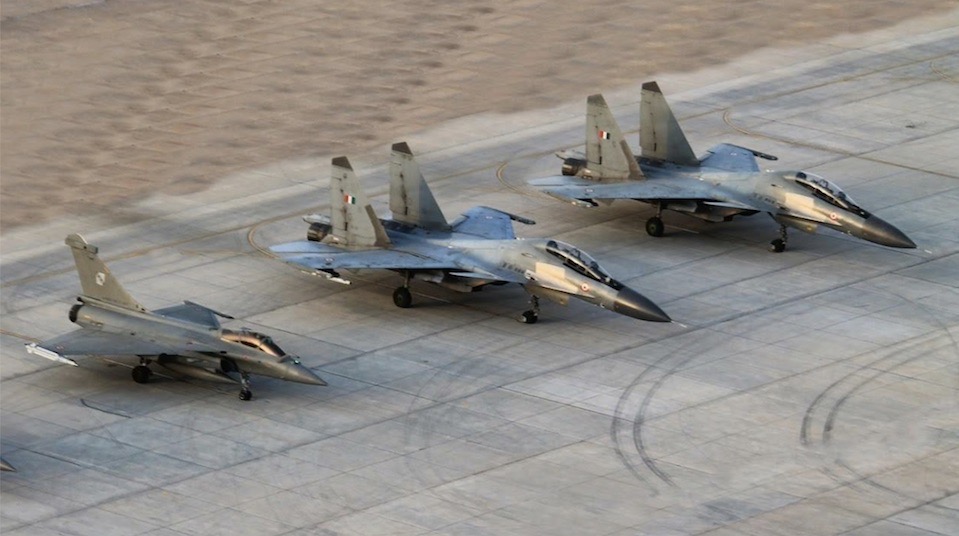
Rafale Medium Fighter and Su-30MKI Heavyweight Fighter
India’s contract for 36 Rafale fighters has cost a tremendous €7.8 billion ($8.721 billion), leading to widespread allegations of corruption within the government and leading to very serious questions among analysts around the world regarding the cost effectiveness of such a purchase. Under the contract India has paid $242 million per fighter - making it the most costly in the world including much heavier and more sophisticated American and Russian designs. The cost is considered to largely be a result of the very low efficiency of France’s defence sector and its military aviation in particular, and leave the Rafale costing over 50% more than the American F-35A and 41% more than the F-15QA - valuing all three as part of export packages. The F-15QA outperforms the Rafale across the spectrum, while the F-35A represents a state of the art fifth generation design which will continue to be upgraded and integrate new subsystems for at least four more decades and boasts far more advanced sensors, avionics and stealth capabilities. The gap in cost effectiveness is greater still when compared to Russian designs such as the Su-57 fifth generation fighter and Su-34 strike fighter.
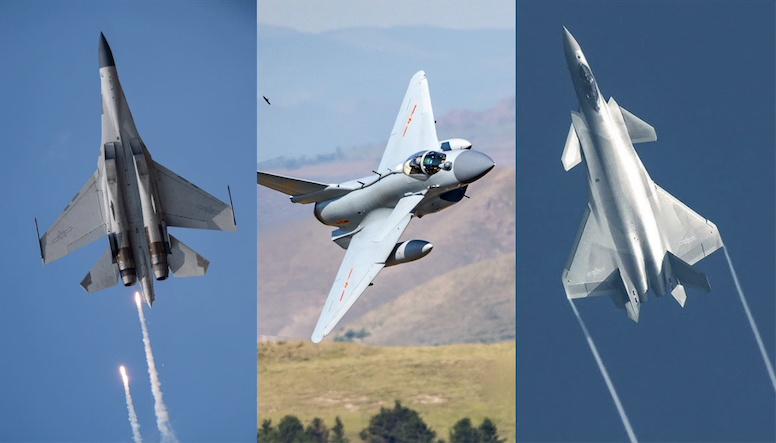
(from left) J-16, J-10C and J-20 Next Generation Fighters
The Rafale’s extreme cost means that should the Indian Air Force invest in acquiring large numbers of the aircraft, each squadron will take a disproportionate amount of the defence budget and provide a relatively unexceptional capability in return. The potential implications of this are particularly serious when comparing the Rafale to state of the art Chinese designs such as the J-10C, J-16 and J-20 next generation platforms. Because defence manufacturers generally make a much smaller profit when selling to the country’s own armed forces, which applies to the U.S., France, China and others, the Chinese Air Force will pay considerably less to acquire aircraft which are both much heavier and more sophisticated than the Rafale. This combined with the generally far greater efficiency of China’s defence sector relative to France, with China benefitting from much higher purchasing power and manufacturing military aircraft on a much larger scale, means that it will be completely unaffordable for India to attempt to maintain any semblance of a favourable balance of power by purchasing Rafale fighters.
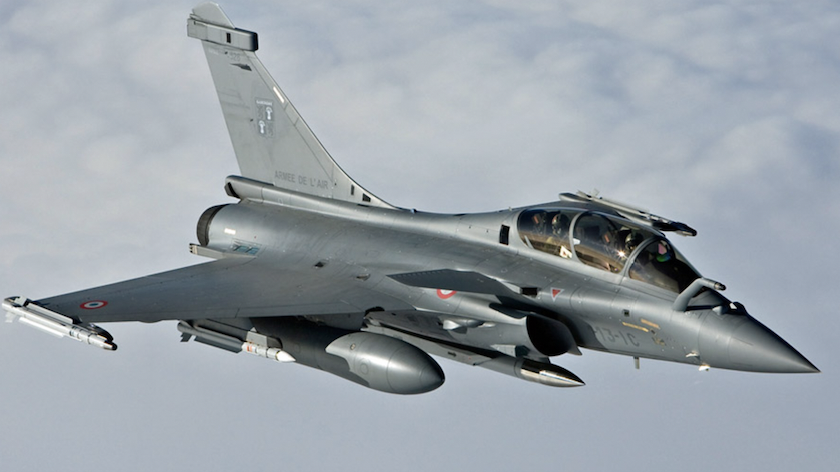
Rafale Medium Fighter
Regarding combat performance, comparing the Rafale with the latest Chinese designs is indicative of both the far greater research and development budget in China relative to France, the country’s much larger and more efficient defence sector and the Rafale’s greater age. Although China’s Air Force is thought to be able to purchase J-20 fighters for less than a third the cost that India imports Rafale fighters from France, the discrepancy in capabilities is massive favouring the Chinese jet and the two are from entirely different generations and weight ranges. A cheaper Chinese aircraft from a lighter weight range and from the same generation as the Rafale, the J-16’s cost is well under a fifth that which India pays for Rafale fighters. The aircraft nevertheless retains superior capabilities across the spectrum. While the Rafale has a maximum speed below average at Mach 1.8, the J-16 is 40% faster and can comfortably exceed Mach 2.2.
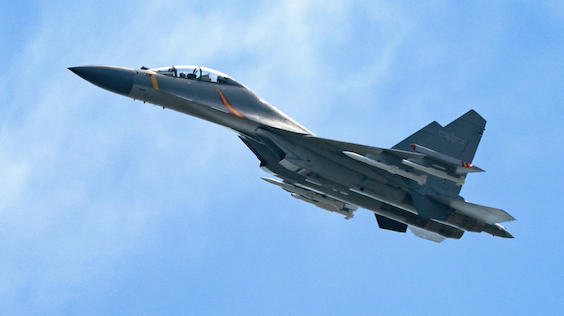
Chinese J-16 Heavyweight Fighter
The Rafale has a low flight ceiling at around 15km, providing the J-16 with a considerable advantage as it can operate at much higher 20km altitudes. The Rafale’s M88 engines put out a very low level of thrust at 75kN, while the WS-10B is around twice as powerful with an estimated thrusts of 145-150kN. This gives the Chinese jet a far superior flight performance and a better thrust/weight ratio. The Rafale’s endurance is also very limited, and its range is very restricted when carrying a full weapons payload, which compares poorly to the J-16’s high endurance design.
While the latest Rafale variants integrate AESA radars, these are much smaller than those on the J-16 which seriously restricts situational awareness. Although both deploy air to air missiles with comparable ranges, the Meteor and PL-15 respectively, the Chinese missile is guided by an AESA rather than a passive radar making it much more difficult to jam and therefore more reliable. The Rafale’s only notable advantage, other than its low fuel consumption, is its lower radar cross section largely by virtue of it being a much smaller aircraft. The J-16 largely compensates for this however with application of advanced radar absorbent coatings - something the Rafale lacks.
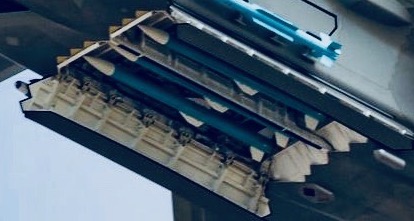
PL-15 Long Range Air to Air Missiles
Ultimately should India seek to build a modern fighter fleet capable of challenging China, which currently deploys the world’s second largest fleet of fifth generation fighters and is expanding and modernising rapidly, the Rafale offers an extremely poor return on investment and can be considered both overpriced and underpowered. Given significant qualitative problems with French built fighters which have emerged after strenuous use, Taiwan’s Mirage 2000 fleet being a key example, this is an all the more serious issue. The Rafale when purchased by India is not only several times as expensive as even the most elite Chinese designs, but is also unable to match the latest Chinese fighters which benefit from high end technologies developed by a colossal defence sector which dwarfs that of France. With India's defence budget under a third that of China, this is totally unsustainable. More feasible options will be the pursuit of a domestic next generation fighter with Russian support, acquisition of Russian MiG-35 and Su-57 next generation fighters which have a cost a small fraction of that of the Rafale and are in many ways much more capable, and pursuit of upgrades to the existing Su-30MKI fleet possibly including integration of AESA radars, new AL-41 engines and new electronic warfare systems.
Why French Rafale Fighters and Meteor Missiles Can’t Solve India’s Problem with China’s Air Force
You are using an out of date browser. It may not display this or other websites correctly.
You should upgrade or use an alternative browser.
You should upgrade or use an alternative browser.
China kills twenty Indian soldiers .... heading to the war!!!
- Thread starter Zeeman
- Start date
China, India agree to reduce tensions after deadly clash
Updated 3 min 53 sec ago
June 23, 2020

The June 15 violence took place around 4,500 meters (15,000 feet) above sea level in the Galwan valley. (File/AFP)
The June 15 battle, reportedly fought with fists, clubs and rocks, was the first time troops have been killed on their border since 1975 and marked a major deterioration in ties between the two Asian giants.
Chinese foreign ministry spokesman Zhao Lijian said that after talks between the top regional military commanders on Monday, both sides “agreed to take necessary measures to promote a cooling of the situation.”
The Press Trust of India said the meeting was between Lt. Gen. Harinder Singh, commander of the 14 Corps, and Major General Liu Lin, commander of the Tibet Military District.
“The holding of this meeting shows that both sides want to deal with their disagreement, manage the situation and de-escalate the situation through dialogue and consultations,” Zhao told a regular news conference.
The two sides “exchanged frank and in-depth views” and “agreed to maintain dialogue and jointly committed to promoting peace and tranquility in the border areas,” Zhao added.
There was no official comment from New Delhi but an Indian army source said that after the meeting, reportedly lasting almost 11 hours, that there was a “mutual consensus to disengage.”
He added that ways to reduce frictions in the Ladakh region opposite Tibet “were discussed and will be taken forward by both the sides.”
The source gave no further details, but the clashes followed an earlier agreement to disengage struck in early June after weeks of rising tensions that included several brawls.
The June 15 violence took place around 4,500 meters (15,000 feet) above sea level in the Galwan valley, where both sides accuse each other of encroaching on their respective territory.
China has said it suffered casualties but has not given more details. Indian media reports suggested there were more than 40 casualties on the Chinese side.
The meeting between military commanders came ahead of virtual talks between the foreign ministers of India, China and Russia later Tuesday, ostensibly to discuss the coronavirus.

Updated 3 min 53 sec ago
June 23, 2020
The June 15 violence took place around 4,500 meters (15,000 feet) above sea level in the Galwan valley. (File/AFP)
- Both sides “agreed to take necessary measures to promote a cooling of the situation”
- The meeting between military commanders came ahead of virtual talks between the foreign ministers of India, China and Russia
The June 15 battle, reportedly fought with fists, clubs and rocks, was the first time troops have been killed on their border since 1975 and marked a major deterioration in ties between the two Asian giants.
Chinese foreign ministry spokesman Zhao Lijian said that after talks between the top regional military commanders on Monday, both sides “agreed to take necessary measures to promote a cooling of the situation.”
The Press Trust of India said the meeting was between Lt. Gen. Harinder Singh, commander of the 14 Corps, and Major General Liu Lin, commander of the Tibet Military District.
“The holding of this meeting shows that both sides want to deal with their disagreement, manage the situation and de-escalate the situation through dialogue and consultations,” Zhao told a regular news conference.
The two sides “exchanged frank and in-depth views” and “agreed to maintain dialogue and jointly committed to promoting peace and tranquility in the border areas,” Zhao added.
There was no official comment from New Delhi but an Indian army source said that after the meeting, reportedly lasting almost 11 hours, that there was a “mutual consensus to disengage.”
He added that ways to reduce frictions in the Ladakh region opposite Tibet “were discussed and will be taken forward by both the sides.”
The source gave no further details, but the clashes followed an earlier agreement to disengage struck in early June after weeks of rising tensions that included several brawls.
The June 15 violence took place around 4,500 meters (15,000 feet) above sea level in the Galwan valley, where both sides accuse each other of encroaching on their respective territory.
China has said it suffered casualties but has not given more details. Indian media reports suggested there were more than 40 casualties on the Chinese side.
The meeting between military commanders came ahead of virtual talks between the foreign ministers of India, China and Russia later Tuesday, ostensibly to discuss the coronavirus.
Secondly i my personal thinking, i see F35 coming on indian side soon if new F16 with 120D is given to Pakistan by Americans.Why French Rafale Fighters and Meteor Missiles Can’t Solve India’s Problem with China’s Air Force
Following multiple border clashes with Pakistan in 2019 and more recently with Chinese forces in Galwan Valley, a number of Indian officials and military analysts have referred to the French Rafale fighter as a guarantor of a favourable outcome in future conflicts. The Rafale is a ‘4+ generation’ French fighter which first flew in 1986, and the Indian Air Force plans to induct 36 of the aircraft into service by 2025. The fighter is particularly prized for its low operational cost and maintenance requirements, although its compatibility with Meteor and SCALP missiles and respectable avionics have also been attractive. Despite these strengths however, the Rafale’s ability to seriously benefit Indian operations against China in particular remain extremely limited for a number of reasons.

Rafale Medium Fighter and Su-30MKI Heavyweight Fighter
India’s contract for 36 Rafale fighters has cost a tremendous €7.8 billion ($8.721 billion), leading to widespread allegations of corruption within the government and leading to very serious questions among analysts around the world regarding the cost effectiveness of such a purchase. Under the contract India has paid $242 million per fighter - making it the most costly in the world including much heavier and more sophisticated American and Russian designs. The cost is considered to largely be a result of the very low efficiency of France’s defence sector and its military aviation in particular, and leave the Rafale costing over 50% more than the American F-35A and 41% more than the F-15QA - valuing all three as part of export packages. The F-15QA outperforms the Rafale across the spectrum, while the F-35A represents a state of the art fifth generation design which will continue to be upgraded and integrate new subsystems for at least four more decades and boasts far more advanced sensors, avionics and stealth capabilities. The gap in cost effectiveness is greater still when compared to Russian designs such as the Su-57 fifth generation fighter and Su-34 strike fighter.

(from left) J-16, J-10C and J-20 Next Generation Fighters
The Rafale’s extreme cost means that should the Indian Air Force invest in acquiring large numbers of the aircraft, each squadron will take a disproportionate amount of the defence budget and provide a relatively unexceptional capability in return. The potential implications of this are particularly serious when comparing the Rafale to state of the art Chinese designs such as the J-10C, J-16 and J-20 next generation platforms. Because defence manufacturers generally make a much smaller profit when selling to the country’s own armed forces, which applies to the U.S., France, China and others, the Chinese Air Force will pay considerably less to acquire aircraft which are both much heavier and more sophisticated than the Rafale. This combined with the generally far greater efficiency of China’s defence sector relative to France, with China benefitting from much higher purchasing power and manufacturing military aircraft on a much larger scale, means that it will be completely unaffordable for India to attempt to maintain any semblance of a favourable balance of power by purchasing Rafale fighters.

Rafale Medium Fighter
Regarding combat performance, comparing the Rafale with the latest Chinese designs is indicative of both the far greater research and development budget in China relative to France, the country’s much larger and more efficient defence sector and the Rafale’s greater age. Although China’s Air Force is thought to be able to purchase J-20 fighters for less than a third the cost that India imports Rafale fighters from France, the discrepancy in capabilities is massive favouring the Chinese jet and the two are from entirely different generations and weight ranges. A cheaper Chinese aircraft from a lighter weight range and from the same generation as the Rafale, the J-16’s cost is well under a fifth that which India pays for Rafale fighters. The aircraft nevertheless retains superior capabilities across the spectrum. While the Rafale has a maximum speed below average at Mach 1.8, the J-16 is 40% faster and can comfortably exceed Mach 2.2.

Chinese J-16 Heavyweight Fighter
The Rafale has a low flight ceiling at around 15km, providing the J-16 with a considerable advantage as it can operate at much higher 20km altitudes. The Rafale’s M88 engines put out a very low level of thrust at 75kN, while the WS-10B is around twice as powerful with an estimated thrusts of 145-150kN. This gives the Chinese jet a far superior flight performance and a better thrust/weight ratio. The Rafale’s endurance is also very limited, and its range is very restricted when carrying a full weapons payload, which compares poorly to the J-16’s high endurance design.
While the latest Rafale variants integrate AESA radars, these are much smaller than those on the J-16 which seriously restricts situational awareness. Although both deploy air to air missiles with comparable ranges, the Meteor and PL-15 respectively, the Chinese missile is guided by an AESA rather than a passive radar making it much more difficult to jam and therefore more reliable. The Rafale’s only notable advantage, other than its low fuel consumption, is its lower radar cross section largely by virtue of it being a much smaller aircraft. The J-16 largely compensates for this however with application of advanced radar absorbent coatings - something the Rafale lacks.

PL-15 Long Range Air to Air Missiles
Ultimately should India seek to build a modern fighter fleet capable of challenging China, which currently deploys the world’s second largest fleet of fifth generation fighters and is expanding and modernising rapidly, the Rafale offers an extremely poor return on investment and can be considered both overpriced and underpowered. Given significant qualitative problems with French built fighters which have emerged after strenuous use, Taiwan’s Mirage 2000 fleet being a key example, this is an all the more serious issue. The Rafale when purchased by India is not only several times as expensive as even the most elite Chinese designs, but is also unable to match the latest Chinese fighters which benefit from high end technologies developed by a colossal defence sector which dwarfs that of France. With India's defence budget under a third that of China, this is totally unsustainable. More feasible options will be the pursuit of a domestic next generation fighter with Russian support, acquisition of Russian MiG-35 and Su-57 next generation fighters which have a cost a small fraction of that of the Rafale and are in many ways much more capable, and pursuit of upgrades to the existing Su-30MKI fleet possibly including integration of AESA radars, new AL-41 engines and new electronic warfare systems.
Why French Rafale Fighters and Meteor Missiles Can’t Solve India’s Problem with China’s Air Force
I am not export as all of you guys, so can be wrong. But i have stronge feeling due few reason's,
Americans will not leave india weak agiant china , china already have 5th gen in there line in form of J22 and coming J31 and J35 in future, can be any other in near future, read somewhere china also in talk of SU 57 with Russia.
Second point F16 new one will be peanuts for us to keep quite and have some balance in area too. If F35 given to Indian
India going for 60 + or 70 apx Tajas out of 114 total requirement numbers, this still open 54 + aircraft space and 9 billion out of total 15 billion.
Note: upfront cost of F35 is less then Rafale (per unit cost).
I think Chinese goal was to humiliate and put India back to the place where they really belong.
They wanted to show the world that they are powerful militarily and India can be destabilized at their will.
India wanted 1000 companies to leave China and come to India.
China wasn’t happy..... a nice message to America’s bitch to stay in their hole...
They wanted to show the world that they are powerful militarily and India can be destabilized at their will.
India wanted 1000 companies to leave China and come to India.
China wasn’t happy..... a nice message to America’s bitch to stay in their hole...
Counter-Errorist
THINK TANK
Unlikely. China's policy has been two steps forward, one step backward. They gave India enough room to fallback, save face without needing to escalate.China, India agree to reduce tensions after deadly clash
Updated 3 min 53 sec ago
June 23, 2020
View attachment 13976
The June 15 violence took place around 4,500 meters (15,000 feet) above sea level in the Galwan valley. (File/AFP)
NEW DELHI: China and India have agreed to reduce tensions a week after clashes on their disputed Himalayan border left 20 Indian troops dead in brutal hand-to-hand fighting.
- Both sides “agreed to take necessary measures to promote a cooling of the situation”
- The meeting between military commanders came ahead of virtual talks between the foreign ministers of India, China and Russia
The June 15 battle, reportedly fought with fists, clubs and rocks, was the first time troops have been killed on their border since 1975 and marked a major deterioration in ties between the two Asian giants.
Chinese foreign ministry spokesman Zhao Lijian said that after talks between the top regional military commanders on Monday, both sides “agreed to take necessary measures to promote a cooling of the situation.”
The Press Trust of India said the meeting was between Lt. Gen. Harinder Singh, commander of the 14 Corps, and Major General Liu Lin, commander of the Tibet Military District.
“The holding of this meeting shows that both sides want to deal with their disagreement, manage the situation and de-escalate the situation through dialogue and consultations,” Zhao told a regular news conference.
The two sides “exchanged frank and in-depth views” and “agreed to maintain dialogue and jointly committed to promoting peace and tranquility in the border areas,” Zhao added.
There was no official comment from New Delhi but an Indian army source said that after the meeting, reportedly lasting almost 11 hours, that there was a “mutual consensus to disengage.”
He added that ways to reduce frictions in the Ladakh region opposite Tibet “were discussed and will be taken forward by both the sides.”
The source gave no further details, but the clashes followed an earlier agreement to disengage struck in early June after weeks of rising tensions that included several brawls.
The June 15 violence took place around 4,500 meters (15,000 feet) above sea level in the Galwan valley, where both sides accuse each other of encroaching on their respective territory.
China has said it suffered casualties but has not given more details. Indian media reports suggested there were more than 40 casualties on the Chinese side.
The meeting between military commanders came ahead of virtual talks between the foreign ministers of India, China and Russia later Tuesday, ostensibly to discuss the coronavirus.
View attachment 13977
Counter-Errorist
THINK TANK
Agree with this. India is China's only viable competitor in the region. Americans are unlikely to abandon them.Americans will not leave india weak agiant china , china already have 5th gen in there line in form of J22 and coming J31 and J35 in future, can be any other in near future, read somewhere china also in talk of SU 57 with Russia.
Last thing America needs is its F-35 in the hands of Indian incompetent Airforce .With F-22 production stopped and F-35 taking place as US next generation fighter ,US would be foolish to give these jets to India considering how sophisticated the technology is, with possibility of Russia getting its hands on F-35 from its ally India, crash rate of Indian Air Force and very less experience of Indian Air Force with American fighters tech , sales of F-35 to India will only bring bad luck for US and If US decides to offer India its F-35 it will probably be after 2028 or before if US feels the need to slow down India's so called Indigenous HAL AMCA project by dragging the deal for yearsSecondly i my personal thinking, i see F35 coming on indian side soon if new F16 with 120D is given to Pakistan by Americans.
I am not export as all of you guys, so can be wrong. But i have stronge feeling due few reason's,
Americans will not leave india weak agiant china , china already have 5th gen in there line in form of J22 and coming J31 and J35 in future, can be any other in near future, read somewhere china also in talk of SU 57 with Russia.
Second point F16 new one will be peanuts for us to keep quite and have some balance in area too. If F35 given to Indian
India going for 60 + or 70 apx Tajas out of 114 total requirement numbers, this still open 54 + aircraft space and 9 billion out of total 15 billion.
Note: upfront cost of F35 is less then Rafale (per unit cost).
Ab bus altaf bhai ki tarhaan aik papi idher aur aik papi udher....Need to say more ?
View attachment 13997
Path-Finder
MEMBER
Beijing troops carve a map of their country and write 'China' in giant letters on disputed border land with India
PUBLISHED: 10:04 EDT, 30 June 2020 | UPDATED: 11:59 EDT, 30 June 2020
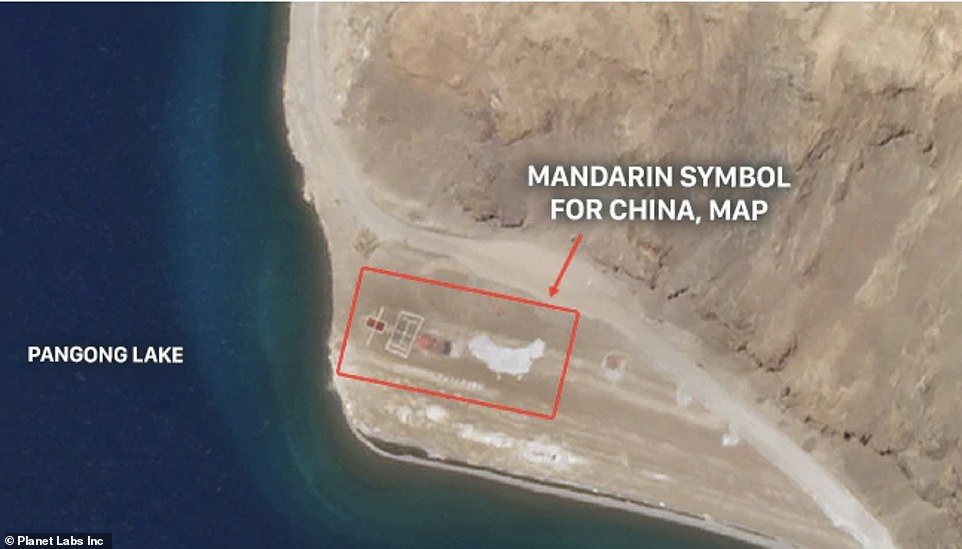
Beijing has staked its claim on a piece of disputed land near the border with India, by writing the word 'China' on it in huge letters.
Satellite images show Mandarin characters meaning 'China' written near the shore of Pangong Lake, a remote area of disputed territory high in the Himalayas.
Troops also appear to have drawn a map of China on part of the lake shore, which is located close to the site of vicious hand-to-hand clashes between Indian and Chinese troops back in May.
Satellite images show what appears to be Mandarin letters spelling 'China' (left) and a map of the country (right) scrawled on the shoreline of a lake near the disputed border with India
Pangong Lake, located at 14,000ft in the Himalayas, is divided into 'fingers' of territory by India and China - marked one to eight on this map. India claims the whole coastline, up to finger eight (border shown at the top). China claims up to 'finger four' (border shown in the centre of the map, with disputed territory in yellow). The Chinese writing has appeared close to that line, marked by the Chinese flag. Another Chinese base has been built further up the coast, also shown by a Chinese flag
Pangong Lake is located along the disputed Line of Actual Control which roughly marks the border between the two nuclear-armed powers.
It is 75 miles to the south of the Galwan Valley, another area where clashes have taken place in recent months and where China has been building new bases.
Indian and Chinese forces divide the area around Pangong into 'fingers' - ridges of land that run down from the peak of a nearby mountain to the lake shore.
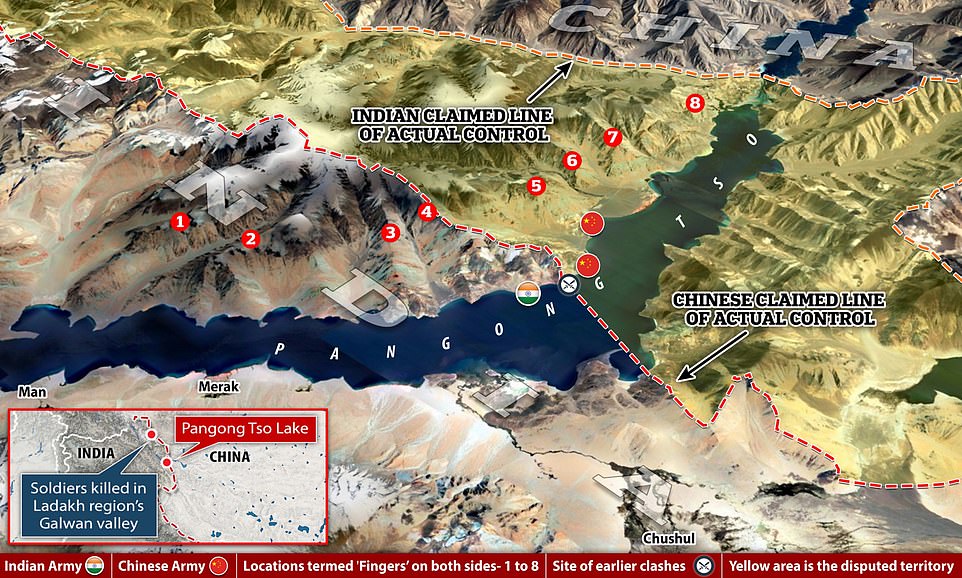
India claims ownership of the entire shoreline - from 'finger one' at the northwestern tip of the lake up to 'finger eight' at the southeastern end.
However, China has recently staked a claim on the territory from 'finger eight' to 'finger four' which is located roughly halfway along the shore.
The tip of 'finger four' is where troops from both sides are though to have fought earlier this year, after China was accused of impeding an Indian patrol.
Satellite images also show what appears to be a Chinese-built pier with fast water craft parked on it at the base of 'finger five' (left) and new construction on the Chinese-claimed side of 'finger four', where clashes took place in May (right)
China has built at least 186 huts (pictured, some of the huts) on disputed territory which it claims, including up to five miles inland, Indian media reported
India now accuses China of occupying the disputed territory, and refusing to let its troops move past 'finger four'.
Analysis of the images carried out by Indian station NDTV also reveals significant Chinese construction in the disputed zone between fingers four and eight.
At least 186 huts are now visible along the stretch of shoreline and extending five miles up a ridge-line which runs inland, the site reports.
Significant construction is also taking place on the tip of 'finger four', images show.
A pier with two fast water craft has also been constructed at the tip of 'finger five'.
China and India have been involved in a series of border confrontations in recent weeks that each has blamed on the other.
India sends fighter jets for combat onto disputed valley with China
The most serious came in the Galwan Valley on June 15, when soldiers armed with spiked clubs and rocks were involved in a vicious fight that left 20 Indians and an unknown number of Chinese dead.
Soldiers fought hand-to-hand because of a 1996 agreement that bans firearms and explosives from the border region.
Clashes also broke out on the shores of Pangong between May 5 and 6 when scores of troops were again involved in close-quarters fighting.
Some Indian troops were injured badly enough that they had to be evacuated by helicopter, though no casualties were reported.
Since the Galwan Valley confrontation both sides have agreed to engage in high-level military talks, aimed at 'disengaging' in the region.
However, India has admitted that 'large numbers' of its troops have been sent to the region, which it says it necessary to counter a Chinese military build-up that began in early May.
The lake is 75 miles south of the Galwan Valley, where 20 Indian troops were killed in clashes with the Chinese earlier this month, and where China is also building new camps (pictured)
Relatives mourn Indian soldiers killed in border clash with China
Beijing has refused to comment on the ongoing dispute.
The Himalayan border between India and China has been disputed for centuries, but the two countries have been fighting over it most recently since the 1960s.
In the 18th century it was fought over by the Russian, Chinese and British empires, and after India gained independence ownership of the region became more confused.
China values the region because it provides a trading route to Pakistan, and recent hostilities have been sparked by fears in Beijing that India will cut it off from the crucial overland corridor.
The current official border between the two was set by Britain and is known as the McMahon line. It is recognised by India but not by China.
In reality, the border between the two countries is on Line of Actual Control (LAC) where Indian and Chinese forces finished after the Sino-Indian War of 1962.
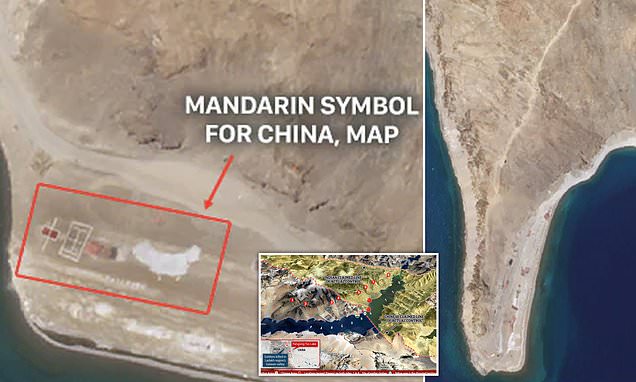
 www.dailymail.co.uk
www.dailymail.co.uk
I guess the Chinese are pranking the Satellite photo business
- Chinese troops have laid claim to a piece of land near the Indian border by writing 'China' on it in huge letters
- Beijing's men also appear to have drawn a map of China on the land, located on the shores of Pangong Lake
- Satellite images also show China has built 180 huts on a stretch of coastline that is claimed by both sides
- The lake is located 75 miles south of the Galwan Valley, where deadly clashes between troops took place
PUBLISHED: 10:04 EDT, 30 June 2020 | UPDATED: 11:59 EDT, 30 June 2020

Beijing has staked its claim on a piece of disputed land near the border with India, by writing the word 'China' on it in huge letters.
Satellite images show Mandarin characters meaning 'China' written near the shore of Pangong Lake, a remote area of disputed territory high in the Himalayas.
Troops also appear to have drawn a map of China on part of the lake shore, which is located close to the site of vicious hand-to-hand clashes between Indian and Chinese troops back in May.
Satellite images show what appears to be Mandarin letters spelling 'China' (left) and a map of the country (right) scrawled on the shoreline of a lake near the disputed border with India
Pangong Lake, located at 14,000ft in the Himalayas, is divided into 'fingers' of territory by India and China - marked one to eight on this map. India claims the whole coastline, up to finger eight (border shown at the top). China claims up to 'finger four' (border shown in the centre of the map, with disputed territory in yellow). The Chinese writing has appeared close to that line, marked by the Chinese flag. Another Chinese base has been built further up the coast, also shown by a Chinese flag
Pangong Lake is located along the disputed Line of Actual Control which roughly marks the border between the two nuclear-armed powers.
It is 75 miles to the south of the Galwan Valley, another area where clashes have taken place in recent months and where China has been building new bases.
Indian and Chinese forces divide the area around Pangong into 'fingers' - ridges of land that run down from the peak of a nearby mountain to the lake shore.

India claims ownership of the entire shoreline - from 'finger one' at the northwestern tip of the lake up to 'finger eight' at the southeastern end.
However, China has recently staked a claim on the territory from 'finger eight' to 'finger four' which is located roughly halfway along the shore.
The tip of 'finger four' is where troops from both sides are though to have fought earlier this year, after China was accused of impeding an Indian patrol.
Satellite images also show what appears to be a Chinese-built pier with fast water craft parked on it at the base of 'finger five' (left) and new construction on the Chinese-claimed side of 'finger four', where clashes took place in May (right)
China has built at least 186 huts (pictured, some of the huts) on disputed territory which it claims, including up to five miles inland, Indian media reported
India now accuses China of occupying the disputed territory, and refusing to let its troops move past 'finger four'.
Analysis of the images carried out by Indian station NDTV also reveals significant Chinese construction in the disputed zone between fingers four and eight.
At least 186 huts are now visible along the stretch of shoreline and extending five miles up a ridge-line which runs inland, the site reports.
Significant construction is also taking place on the tip of 'finger four', images show.
A pier with two fast water craft has also been constructed at the tip of 'finger five'.
China and India have been involved in a series of border confrontations in recent weeks that each has blamed on the other.
India sends fighter jets for combat onto disputed valley with China
The most serious came in the Galwan Valley on June 15, when soldiers armed with spiked clubs and rocks were involved in a vicious fight that left 20 Indians and an unknown number of Chinese dead.
Soldiers fought hand-to-hand because of a 1996 agreement that bans firearms and explosives from the border region.
Clashes also broke out on the shores of Pangong between May 5 and 6 when scores of troops were again involved in close-quarters fighting.
Some Indian troops were injured badly enough that they had to be evacuated by helicopter, though no casualties were reported.
Since the Galwan Valley confrontation both sides have agreed to engage in high-level military talks, aimed at 'disengaging' in the region.
However, India has admitted that 'large numbers' of its troops have been sent to the region, which it says it necessary to counter a Chinese military build-up that began in early May.
The lake is 75 miles south of the Galwan Valley, where 20 Indian troops were killed in clashes with the Chinese earlier this month, and where China is also building new camps (pictured)
Relatives mourn Indian soldiers killed in border clash with China
Beijing has refused to comment on the ongoing dispute.
The Himalayan border between India and China has been disputed for centuries, but the two countries have been fighting over it most recently since the 1960s.
In the 18th century it was fought over by the Russian, Chinese and British empires, and after India gained independence ownership of the region became more confused.
China values the region because it provides a trading route to Pakistan, and recent hostilities have been sparked by fears in Beijing that India will cut it off from the crucial overland corridor.
The current official border between the two was set by Britain and is known as the McMahon line. It is recognised by India but not by China.
In reality, the border between the two countries is on Line of Actual Control (LAC) where Indian and Chinese forces finished after the Sino-Indian War of 1962.

Beijing troops write 'China' in giant letters on border with India
Satellite images have revealed giant Mandarin letters spelling the word 'China' along with a map of the country that has been carved on a piece of land that Beijing claims along the Indian border.
I guess the Chinese are pranking the Satellite photo business
Pak moved fresh forces on Kargil front.... any significance?
Is it a routine change or something different? I don't think if there was an attempt of any kind by Pak, we would know about it in advance or be able to monitor it. If this is at all true, it may just be to add pressure on India.
AdditionalIs it a routine change or something different? I don't think if there was an attempt of any kind by Pak, we would know about it in advance or be able to monitor it. If this is at all true, it may just be to add pressure on India.
